Surgical suites incorporate sophisticated lighting design to enable today’s common minimally invasive surgeries and other increasingly image-based procedures.
Anne L. Fischer, Senior Editor
The state-of-the-art surgical suite is a streamlined center where efficient work flow is key. Fluoroscopes, ultrasound units, electrocauteries, cutting devices, video cameras, robots and more are positioned where needed and pushed out of the way when not in use. The big, boxy computer monitor of yesterday has been replaced by flat panel displays on arms that bring images of the surgical field into view for the surgeon. Cables no longer drape the floor and ceiling but instead are housed in ceiling-mounted booms.
All this high-tech equipment enables today’s advanced surgical procedures, which would be ineffective without integrated lighting. Today’s lighting systems must be flexible in terms of movement and positioning as well as intensity control, so that one light is adaptable to different procedures, whether it is open heart surgery, MRI, minimally invasive surgery or telemedicine procedures performed by a robot (Figure 1).
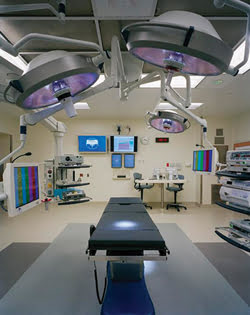
Figure 1. This state-of-the-art surgical suite is shown with three basic lighting types: the large arm-mounted surgical lights, the 2 × 4 fluorescent fixtures and a green light for enhanced viewing of images on the flat panel displays. Photo by Chuck Choi, courtesy of Kaplan McLaughlin Diaz Architects and Perkins Eastman Architects.
Designers of surgical suites help to integrate everything from the tables to the cameras to the picture archiving communications system (PACS). Lighting systems now incorporate cameras on a boom or mounting equipment so that additional imaging devices can be added in the future.
Memorial Sloan-Kettering Cancer Center in New York City recently constructed a 21-room surgical suite featuring a computer/video system that allows staff to monitor the operating rooms internally and remotely. Each room is equipped to handle almost any kind of surgery.
As minimally invasive surgery becomes more prevalent, the lighting becomes more critical, because illumination needs vary from the full light required to see everything in the room to the low or green light necessary to see the flat panel displays that guide the surgeon.
Douglas Gordon, director and senior medical planner at Kaplan McLaughlin Diaz Architects in Portland, Ore., led the team that designed the suite. He noted that, if you entered an operating room just 10 years ago, you found all the lights turned off so surgeons could see what was on the old-style CRT monitors. In some settings, film illuminators provided background lighting as an alternative lower level of lighting. The darkness, however, caused tripping hazards.
Dimmable overhead lights were proposed and tested first, but soon after came the concept of green lighting. According to Gordon, green light is less stressful on the eyes and provides enough background light so that the staff is not bumping into things. The green color also enhances the video images while eliminating the glare that traditional overhead white lights cast on monitors.
Although alternative sources are available, the adjustment options of the dimmable green downlights have provided Sloan-Kettering surgeons with the flexibility to meet their personal preferences. The lighting typically is preset into the computer, so that with one command at the control console in the operating room, it can be adjusted immediately. Gordon noted that dimmable downlights have been installed in three other projects with which his firm has been involved, and the dimmable green lighting has become preferred by surgeons over alternatives that offer less control and a higher green lighting level (Figure 2).
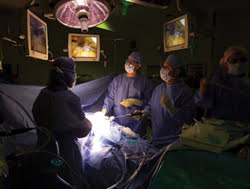
Figure 2. Green light is used in operating rooms to help make displays more visible. Here it is dimmed but still visible. The surgical team is close to the flat screen monitors, which is quite a change from the distance it had to keep from old-style CRT monitors. Courtesy of Memorial Sloan-Kettering Cancer Center.
Preset lighting controls allow staff members to choose the exact intensities and lighting positions they need. The minimum intensity for overhead illumination, as set by the Illuminating Engineering Society of North America, is 100,000 lx. Fixtures with multiple light heads can have 400,000 lux or more. Lighting designs with bulbs that switch off or dim give surgeons and nurses control over intensity (Figure 3).
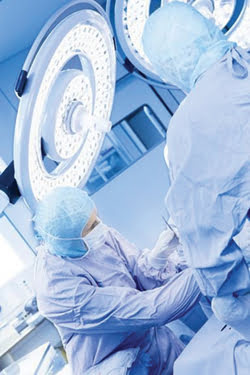
Figure 3. The PowerLED surgical light uses 168 LEDs in 21 modules on the underside of a light head, providing 110,000 lx, or it can be reduced as low as 50 l× for use with minimally invasive surgery. With a fixed color temperature of 3750 K and a color rendering index above 88, surgeons can see colors as they truly are inside the body. Shadows are controlled by sensors on the outside of the light, which identify the position of the surgeon’s head and reduce the output of the LEDs in the obstructed areas. Courtesy of Getinge USA Inc.
User control
Flexible lighting also ensures that one surgical suite can meet all needs. Berchtold Corp. of Charleston, S.C., designs integrated surgical suites and manufactures surgical tables and lighting. It designed surgical suites for the University of California, Los Angeles, Medical Center, where surgeons can control lighting with a touch screen or voice activation, as well as move the operating table, access radiological images from the PACS, adjust surgical equipment and more.
As with most state-of-the-art surgical suites, data collection includes voice recordings, radiology scans, patient data, and images from endoscopic and overhead cameras and from cameras mounted on booms. The lighting for data collection as well as display (and viewing) is critical, yet complicated. In minimally invasive surgery, the lighting requirement is different because the surgeon is directing a probe inside the patient’s body while looking at a screen, which is difficult to read in bright light. This problem is eliminated with user-controlled lighting.
Color, heat and shadows
Distinguishing red from blue, green or flesh tone is vitally important to a surgeon. Thus, the color rendering index of a light source is important because color reproduction varies with the light source. According to an index developed by the International Commission on Illumination, an excellent color rendition (red looks red) is 100, whereas a poor rendition would be a 0. Color temperature is another consideration, with higher color temperature sources, such as xenon, appearing whiter, and halogen being a warmer light source.
Heat emitted from a light source also affects lighting choices, whether overhead, mounted on a movable boom or in a headlamp. Alan Campbell, product manager of Chromophare surgical lights made by Berchtold, said that heat is an issue, especially in applications where lights are on for extended periods, such as during organ transplants or open heart procedures. It is critical in pediatric work, too, where surgeons work with sensitive tissues. The Chromophare lights deliver more light while ensuring lower heat at the surgical site by transforming unwanted infrared into light. A heat filter absorbs 99 percent of the thermal radiation and dissipates it through the top of the light by using an internal convection circuit.
One problem with having overhead lights on during surgery, no matter how low the intensity, is that they produce a shadow. Getinge USA of Rochester, N.Y., is one manufacturer that has improved shadow control considerably through an innovative optical system using lightguides such as prisms and microlenses to produce overlapping beams. In addition, Berchtold’s cross-shaped light head can be positioned around the surgeon’s head, eliminating shadows.
Where surgeons need more direct illumination, they may choose to wear headlamps. Headlamps direct light at the surgical site, preventing shadows. Enova Medical Technologies of St. Paul, Minn., has a battery-operated headlamp with LEDs as the light source. According to Nicole Juettner, sales director, the headlamps are considered a Class I device by the FDA, which means that they pose less risk to the end user because they run on batteries rather than on AC. When a device — for example, a fiber optic xenon or halogen light source — has a plug, the FDA categorizes it as Class II. Another advantage besides ease of movement is that there are no cords or bulbs to break or degrade, so maintenance costs are reduced.
Halogen, xenon, fluorescent, incandescent and LED light sources all are found in today’s surgical suites. The criteria used in choosing lighting differ according to its use and the user, according to Pam Rockow, product marketing manager at Getinge USA Inc. Surgeons, for example, are concerned with heat and shadow control, whereas operating room nurses look for maneuverability, ease of changing bulbs and cleaning, and facility of integrating the lighting with other equipment.
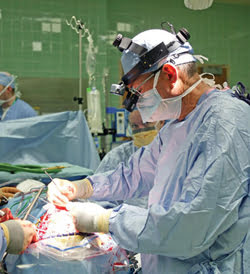
Figure 4. The Halo battery-operated headlamp uses LEDs to shine light directly where needed, shown used in neurosurgery. Courtesy of Enova Medical Technologies.
Light sources
Today’s surgical lighting is mostly halogen according to Jeremy L. Pymento, business manager of the semiconductor and medical business unit for Osram Sylvania in Danvers, Mass., although he expects the light source of the future may be LEDs. Their advantages over halogen or xenon are minimum heat generation at the LED surface and a long lifetime, but according to Pymento, halogen scores high marks for its high color rendering index. Typically, heat generated by standard light sources is minimized by coupling lamps with dichroic reflectors. The reflectors can transmit the infrared radiation through the rear of the lamp and away from the patient.
With white LEDs, minimum heat is generated at the surgical source because most heat generated at the LED chip is dissipated by heat sink materials. The heat is dissipated out the back of the LED, though, which removes it from the surgical site. According to Rockow, LEDs last 30 times as long as halogen bulbs, which means that the light could be good for 10 years with no bulb change. The main challenges for LEDs, however, continue to be in the cost of its system as well as complex optical design requirements for coupling an array of LEDs as compared with a single halogen light source. Manufacturers have begun mass-producing LEDs, but performance is still an issue because color and output can vary from LED to LED; maintaining homogeneity of light in these fixtures also is a challenge.
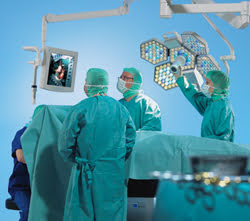
Figure 5. The iLED surgical light has an integrated sterile camera for live transmission of high-contrast images. Courtesy of Trumpf Kreuzer Medizin Systeme GmbH & Co. KG of Rudersberg, Germany.
The iLED from Trumpf Medical Systems, also of Charleston, is a recently introduced adaptive LED-based surgical light (Figure 5). It allows the user to adjust the color temperature for each surgical application. Shadows can be eliminated by turning individual lights on and off. Little heat generates around the surgeon’s head because the light is infrared-free. The lighting system can integrate with an optional remote-control CCD camera that enables the surgeon to take images and store them on a USB memory stick. The light and camera are all operated by an external control unit, by computer or by a light panel.
Enhancements
Although the state-of-the-art surgical suite already looks futuristic, more advances are in store as lighting becomes even smarter. Smart lighting is computer controlled and integrated with video and minimally invasive surgical equipment. In some instances, video and data are sent to remote centers for input by specialists or for distance learning.
At Sloan-Kettering, the surgical suites have what the surgeons and nurses refer to as the “wall of knowledge,” which consists of several flat panel screens mounted on the wall, in addition to those hung on extended arms (Figure 6). According to Gordon, the displays show patient information, vital signs, information on the operating team, PACS data or whatever the staff wants to see. A nurse at an outside control desk also can monitor the information. Today the controls are touch screens within the operating room, but the Sloan-Kettering installation was designed to accommodate voice recognition in the future.
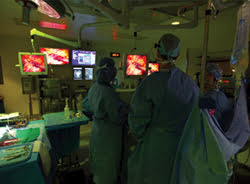
Figure 6. The “wall of knowledge” in an operating room at Memorial Sloan-Kettering Cancer Center shows four flat panel displays on the wall as well as three other screens hanging on arms from the ceiling. Only one of the surgical lights is on and is focused on the left, away from the patient. A dimmable downlight is visible in the ceiling. Courtesy of Memorial Sloan-Kettering Cancer Center.
The next step in enhancing the surgical suite of tomorrow is to go wireless. Cabling already has been removed from the floor, and in the future, cabling in booms also may be a thing of the past.
Data processing and management will continue to advance. Better image capturing systems will work more closely with patient data systems, and video signals will become increasingly digital with high-–definition cameras becoming the norm. Light sources also will advance. The cost of LEDs will come down as manufacturing control improves, and the size of assemblies will decrease. LEDs will become attractive alternatives to halogen and fluorescent overhead lights because of their longevity and will start replacing flexible task lighting throughout the operating room.